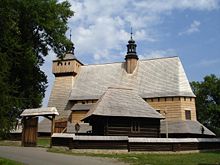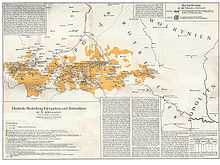Walddeutsche
The term Walddeutsche – coined by the Polish historians Marcin Bielski (1531),[1] Szymon Starowolski (1632), Bishop Ignacy Krasicki,[2] and Wincenty Pol – also sometimes refers to Germans living between Wisłoka and the San River part of the West Carpathian Plateau and the Central Beskidian Piedmont in Poland.The Polish term Głuchoniemcy is a sort of pun; it means "deaf-mutes", but sounds like "forest Germans": Niemcy, Polish for "Germans", is derived from niemy ("mute", unable to talk comprehensibly, i.e. in a Slavic language), and głuchy ("deaf",[3] i.e. "unable to communicate") sounds similar to głusz meaning "wood".The Church of the Assumption of Holy Mary and St. Michael's Archangel in Haczów (Poland), the oldest wooden Gothic temple in Europe, was erected in the 14th century and was added to the UNESCO list of World Heritage Sites in 2003.Marcin Bielski states that Bolesław I Chrobry settled some Germans in the region to defend the borders against Hungary and Kievan Rus' but the arrivals were ill-suited to their task and turned to farming.[10] In 1885, Józef Szujski wrote that the Gluchoniemcy spoke only Polish, but there were traces of a variety of original languages which showed that, when they arrived, the term Niemiec was applied to "everyone".


ŁańcutKrosnoSilesian GermanRoman CatholicismProtestantismPolishGerman-speakinglanguage islandsPolandpolonisedSanockie PitsSlavicisedMarcin BielskiSzymon StarowolskiIgnacy KrasickiWincenty PolWisłokaSan RiverCentral Beskidian PiedmontSlavic languageHaczówUNESCO World Heritage SiteUNESCOWorld Heritage SitesKingdom of PolandSubcarpathian VoivodeshipLesser PolandOstsiedlungCasimir III of PolandCzerwieńBolesław I ChrobryMaciej StryjkowskiPrzeworskPrzemyślJarosławRzeszówMarkowaUmgebindehausKrakówWalddeutscheSubcarpathianMałopolskaPolonizationWacław MaciejowskiSwedishJózef SzujskiPilznoBrzostekGorliceRopczyceWielopole SkrzyńskieFrysztakJasłoCzudecTyczynBrzozówJaćmierzRymanówKańczugaDynówCarpathian GermansGerman minority in PolandPogórzanieAleksander ŚwiętochowskiKasper NiesieckiTatra MountainsMoraviaCarpathiansSlovaksGermanSpiżuWarsawGerman peopleReichsdeutschePalatinesVolksdeutscheDiasporaCzech RepublicSilesiaSudeten GermansHungaryVistulaOlędersGaliciaSlovakiaZipserSwitzerlandBelarusMoldovaBlack SeaRomaniaTransylvanian SaxonsLandlersDanubeHighlandWalserSatu MareBukovinaDobrujaRussiaNorth CaucasusUkraineBessarabiaRussian MennonitesCarpathian RutheniaCrimeaBaltic statesDenmarkNorth SchleswigPotato GermansNorwayFinlandSwedenArmeniaAzerbaijanBulgariaGeorgiaItaly (South Tyrol)YugoslaviaBosnia and HerzegovinaCroatiaSerbiaSloveniaGottscheersBelgiumFrance